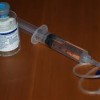Concordance of polymerase chain reaction with human immunodeficiency virus antibody detection
Abstract
To evaluate the correlation of detection of human immunodeficiency virus (HIV) by polymerase chain reaction (PCR) with detection of HIV antibody, 271 simultaneous serum and peripheral blood mononuclear cell samples were examined from 242 persons whose activities placed them at increased risk for HIV infection: 142 from homosexual men, 86 from hemophilic men, and 43 from heterosexual partners of HIV-infected persons.… Read more


